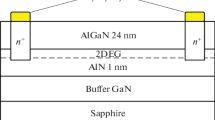Abstract
Nickel contacts based on gallium arsenide are of interest from the point of view of their application in optoelectronics. The aim of this work is to study the contact structures of Ni–p-GaAs and Ni–n-GaAs. The object of study is the electrochemical contacts of nickel to crystalline gallium arsenide. The article presents studies of the topography of homogeneous electrochemical nickel films of nanometer thickness (50–100 nm) on the surface of a semiconductor. The current–voltage characteristics of metal–semiconductor contacts are experimentally obtained. The roughness of the GaAs substrate of the Ni film was studied using optical and probe microscopes. Nickel films were obtained using a Watts solution and a setup for the production of electrochemical structures by the drop method. To minimize the roughness of the nickel surface obtained by electrolysis, a mode of low current density is used. Using a theoretical model and experimental data, the contact resistances are calculated and their current–voltage characteristics are obtained. The parameters of nickel surface roughness, which affect the operational properties of contact structures, are determined. The features of the current flow through the electrochemically obtained Ni–GaAs contacts are revealed. It is shown that the resulting Ni–p-GaAs structures are Ohmic, and the current–voltage characteristics of the Ni–n-GaAs contacts have a nonlinear region at voltages less than 1.5 V. It is shown that the formation of an integral nickel film on the GaAs surface is possible when the Ni layer thickness exceeds the average substrate roughness.










Similar content being viewed by others
REFERENCES
S. M. Sze, Y. Li, and K. K. Ng, Physics of Semiconductor Devices, 4th ed. (Wiley, New Jersey, 2021).
V. V. Pasynkov and L. K. Chirkin, Semiconductor Devices, 9th ed. (Lan’, Moscow, 2021) [in Russian].
T. V. Blank and Yu. A. Gol’dberg, Semiconductors 41 (11), 1263 (2007). https://doi.org/10.1134/S1063782607110012
N. G. Filonov and I. V. Ivonin, Electrophysical Properties of Structures with Schottky Barrier Based on Gallium Arsenide (Tomsk State Univ., Tomsk, 2018) [in Russian].
M. Shur, GaAs Devices and Circuits (Plenum, New York, 1987).
M. V. Lebedev, Semiconductors 54 (7), 699 (2020). https://doi.org/10.1134/S1063782620070064
K. E. Rumyantseva, Physical and Technological Properties of Coatings (Ivanovo State Univ. Chem. Technol., Ivanovo, 2018) [in Russian].
A. G. Berezhnaya, Electrochemical Technologies and Materials (South. Fed. Univ., Rostov-on-Don–Taganrog, 2017) [in Russian].
I. A. Apokin, Technology of Manufacturing Ferromagnetic Films (Fizmatlit, Leningrad, 2016) [in Russian].
S. Virbilis, Electroplating Technology for Craftsmen (Nauka, Moscow, 2017) [in Russian].
N. N. Polyakov, S. V. Mitsuk, and V. V. Filippov, Zavod. Lab. Diagn. Mater. 72 (2), 30 (2006).
B. A. Loginov, P. B. Loginov, V. B. Loginov, and A. B. Loginov, Nanoindustriya 12 (6(92)), 352 (2019). https://doi.org/10.22184/1993-8578.2019.12.6.352.364
C. J. Chen, Introduction to Scanning Tunneling Microscopy (Oxford Univ. Press, New York, 2015).
V. V. Filippov, Peculiarities of Electron Transfer Phenomena in Anisotropic Semiconductors (Sputnik+, Moscow, 2015) [in Russian].
S. E. Luzyanin and Yu. Yu. Sysoeva, “Opportunities of research of transient contact resistance to semiconductor crystals,” in Proc. 4th Int. Sci. Conf. “Young Science—Future of Russia,” Kursk, December 10–11, 2019, Ed. by A. A. Gorokhov (Southwest State Univ., Kursk, 2019), Vol. 7, p. 183.
V. V. Filippov, S. V. Mitsuk, and S. E. Luzyanin, “Measuring the resistance of metal-semiconductor contacts produced by drop electrochemical method,” in Proc. 2nd Int. Conf. on Control Systems, Mathematical Modeling, Automation and Energy Efficiency (SUMMA), Lipetsk, Russia, November 10–13, 2020 (IEEE, 2020), p. 871. https://doi.org/10.1109/SUMMA50634.2020.9280818
L. P. Pavlov, Methods for Measuring Parameters of Semiconductor Materials (Vysshaya Shkola, Moscow, 1987) [in Russian].
V. G. Bozhkov, Metal–Semiconductor Contacts: Physics and Models (Tomsk State Univ., Tomsk, 2016) [in Russian].
V. V. Filippov, S. E. Luzyanin, E. S. Nefedova, and D. V. Tokareva, Izv. Yugo-Zapad. Gos. Univ. Ser. Tekh. Tekhnol. 11 (3), 59 (2021).
Author information
Authors and Affiliations
Corresponding authors
Ethics declarations
The authors declare that they have no conflicts of interest.
Additional information
Translated by N. Wadhwa
Rights and permissions
About this article
Cite this article
Filippov, V.V., Luzyanin, S.E. & Bogonosov, K.A. Features of the Formation of Ni–GaAs Contacts Obtained by Electrolysis and Their Electrophysical Properties. Tech. Phys. 68, 27–34 (2023). https://doi.org/10.1134/S1063784223010036
Received:
Revised:
Accepted:
Published:
Issue Date:
DOI: https://doi.org/10.1134/S1063784223010036




